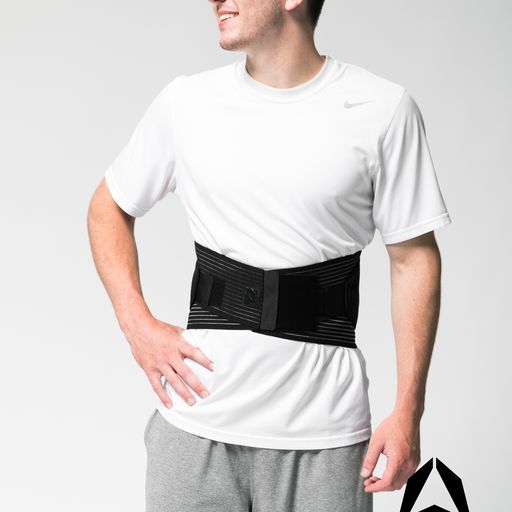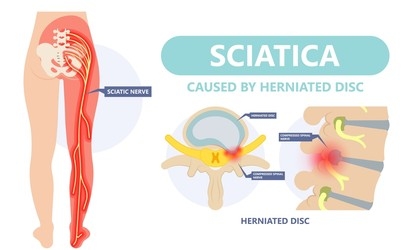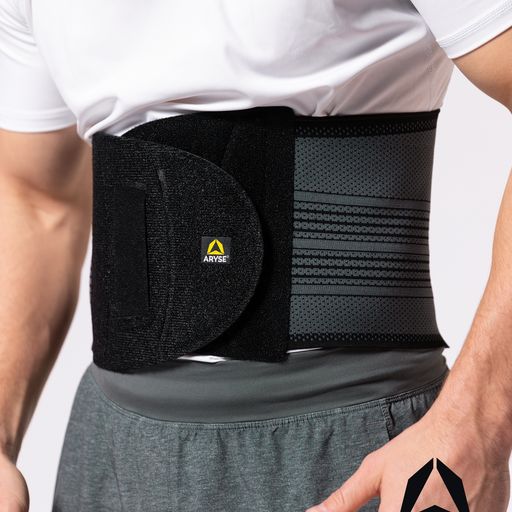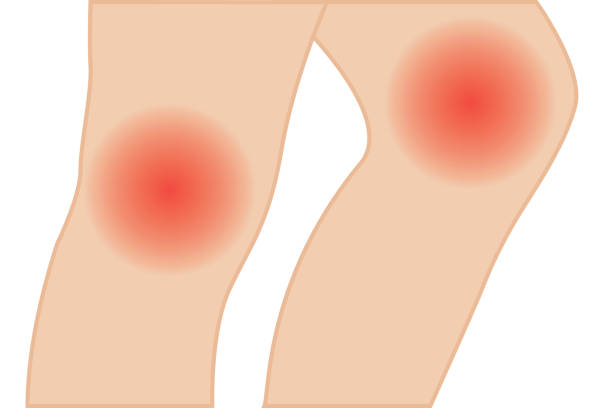



Sciatica is a common type of back pain that affects many adults. It occurs due to pressure on the sciatic nerve, causing a shooting pain that begins in the lower back and radiates down the legs. If you are suffering from sciatica, visit a doctor to see if a brace for sciatica is right for you. Check out our wide selection of Medicare back braces to help you find the best brace for you!
Before we look into how to choose the right brace for sciatica, it’s important to understand what exactly sciatica is.
What is Sciatica?
Sciatica itself is not a condition but it’s a symptom of nerve compression. The nerve may be compressed or pinched because it is being rubbed against a bone, disc, joint, or ligament or due to any other medical condition. The resulting inflammation or swelling causes severe pain and numbness in the affected area.
It’s an extremely painful condition that affects only one side of the lower body. The pain extends from the lower part of the spine through the buttock down your legs. Depending on the location of the sciatica nerve, the pain may also travel down to your foot.
What Causes Sciatica?
As mentioned above, the sciatica nerve can become compressed or pinched due to several medical conditions. These conditions may include:
• Degenerative Disc Disease
• Lumbar Herniated Disk
• Bulging Disc
• Spondylolisthesis
• Spinal Stenosis
• Arthritis
• Trauma such as a fracture in your spine
In addition to that, sciatica nerve pain is also common among pregnant women. As the sciatica nerve runs under the uterus, your fetus may press on it. Wearing a brace for sciatica during pregnancy can relieve pain and treat some of the other symptoms stemming from lumbar back conditions. No matter what contributed to your sciatica pain, Daphco provides a wide range of Medicare back braces to treat all types of lower back pain.
What Are The Symptoms Of Sciatica?
Sciatica nerve pain involves the following symptoms:
• Severe lower back pain traveling down one side of the leg
• Pain in the rear that is worse when sitting
• Severe pain when you cough or sneeze
• Leg pain described as burning, tingling, and stabbing
• Numbness, weakness in leg muscles
• Sharp, stabbing pain – making it difficult to stand or walk
How Does A Brace For Sciatica Useful For Back Pain?
A brace for sciatica provides enough compression and support to alleviate pain, prevent further injury, and accelerate healing. When your lower back is sensitive due to nerve compression, it becomes hard to perform daily activities, e.g., getting up, walking, running, sitting, and turning. A medical brace for sciatica places dual compression and pressure on the lower part of the spine. Applying compression to the lower part of the spine has proved to be a good cure for back pain.
When an individual suffers from back pain due to spinal stenosis or herniated disc, a brace for sciatica is used to reduce the work that is placed on the spine. These pain-relieving braces are also useful for people who have to sit the entire day or whose jobs involve heavy lifting. A back brace for lower back pain will keep your spine in position and prevent it from aggravating.
How To Choose The Right Brace For Sciatica?
Before getting a brace for your back pain, it is essential to visit your doctor. They will perform a complete examination and recommend you the best brace based on the severity of your back pain.
Generally, there are three types of back braces: flexible, semi-rigid, and rigid. Flexible braces are made up of soft materials such as elastic blends/cotton, canvas, neoprene, etc. Semi-rigid braces are made up of somewhat sturdier fabric and it provides more restriction in the movement. Flexible and semi-rigid braces are useful for mild to moderate lower back pain. While rigid braces are used to treat severe back pain and provide assistance in case of spine fractures and post-spinal surgery.
The two most common types of back braces used for sciatica are:
1. Decompression Brace For Sciatica
Decompression back braces are the best solution to treat sciatica. These braces include a rigid low-back support and a decompression belt. The rigid part provides support while the decompression belt expands the low back belt. It expands intervertebral disc space, reduces pressure from the spinal column, and helps reduce pain in the affected area.
2. Sacroiliac (SI) Belts
Sacroiliac belts are useful for sciatica pain that results from sacroiliac joint dysfunction. These belts provide direct compression to stabilize the sacroiliac joints. They restrict the movements of the sacroiliac joint which may irritate or pinch the sciatic nerve. If there’s no irritation to the sciatic nerve, you’re less likely to experience any sciatic pain down the back of your leg. SI belts are suitable for everyday use as they are lightweight which makes them easy and comfortable to wear.
Where To Buy a Brace For Sciatica Online?
Sciatica pain can be either due to never compression or any other condition. Thus when choosing a sciatica back brace, make sure it relieves pain and improves your mobility. Your doctor might recommend you a Medicare brace for sciatica pain but if you need assistance, the Daphco team will help you choose the right brace for your condition. Contact us today to discuss your bracing needs.
Our two most popular braces for sciatica are:
1. ARYSE® ALPHAWRAP® COMPRESSION BACK BRACE

The brace is also suitable for a range of other conditions, including arthritis, back pain, mild postural weakness, sore or strained core muscles, and stiffness. Additionally, for extra compression, you can try the silicon padding brace that can aid in quick recovery.
Features:
• Adjustable compression straps
• Lightweight
• Breathable and comfortable
• Fits comfortably under/over clothing
2. ARYSE® ALPHAWRAP®+ BACK BRACE
The ARYSE® ALPHAWRAP®+ BACK BRACE provides compression for back to treat sciatica pain and protect your back from injury, Its 3D-weave technology and silicone padding ensure a comfortable fit that contours to the lower back and help reduce pain associated with sciatica. This brace provides compression to support the back, relieve pain, and promote recovery from injury.
Ideal for individuals with prophylactic protection needs, arthritis, postural weakness, sore or strained core muscles, and stiffness, the ARYSE ALPHAWRAP+ BACK BRACE is the best option for anyone looking to get rid of back pain due to sciatica or any other condition.
Features:
• Adjustable compression straps
• Lightweight
• Breathable and comfortable
• Fits comfortably under/over clothing
How Long Should You Wear A Brace For Sciatica?
The latest back braces for sciatica are made up of lightweight material. You can wear them all day long or even during sleep. However, wearing a back brace for a long time can cause irritation on the skin. That’s why it is recommended to consult your doctor before wearing a brace for a long time.
Other Natural Ways to Get Rid of Sciatica Pain
Along with using a brace for sciatica, there are many other remedies that you can try at home to get rid of Sciatica pain. Here are some remedies to try at home:
1. Use A Pressure Relief Cushion
Taking rest is important to get rid of sciatica pain but make sure you’re resting the right way. Along with wearing a brace for sciatica, a pressure relief cushion is a valuable tool for managing sciatica pain. Sciatica is a condition characterized by pain radiating along the sciatic nerve, which runs from the lower back down the legs.
A pressure relief cushion helps by evenly distributing weight and reducing pressure on the lower back, thereby reducing pain and discomfort. These cushions come in various shapes and sizes to accommodate different body types and seating arrangements.
The 4 most common types of cushions used for Sciatica pain are:
1. Car Seat Gel Cushion – Used for pain in the lower back region or gluteal area.
2. Memory Foam Seat Cushion – Used for providing support on the sides and ease pain.
3. Donut Shaped Cushion – Used for giving relief from sciatica pain and make you feel stable
4. Cycle Seat Cushion – Used for relieving pressure on sciatica nerves and sitting nerves.
2. Stretch It Out
It may go against your instincts to try a physical activity such as stretching but it is quite effective at reducing sciatica symptoms and strengthening your spine. However, it should be performed gently and slowly. If you think stretching is causing more pain, stop immediately and consult your physiotherapist.
It is recommended to try stretches that are simple enough to try at home. Here are some of the most gentle stretches that can help with Sciatica pain:
• Reclined Pigeon Pose
• Supine Twist
• Seated Forward Bent
• Cat-Cow Stretches
• Bird-Dogs
3. Ice and Heat Therapy
Along with wearing a brace for sciatica, Ice and heat therapy is also a true remedy to get immediate relief from Sciatica pain and speed up the healing process. Heat promotes blood flow to the painful area to speed up healing, while ice and heat may relieve muscle spasms that come with sciatica. Alternate using an ice pack for 15 minutes every hour and heat for 15 minutes every 2-3 hours. Ensure to always place a barrier, such as a towel, between skin and heat or ice, and avoid sleeping while undergoing heat or ice therapy.
4. Anti-Inflammatory Drugs & Steroid Injections
If your pain is not going away with home remedies, it is advised to visit your doctor. Your doctor may give you non-steroidal anti-inflammatory drugs such as Advil and Tylenol to reduce inflammation and provide significant pain relief.
Patients who suffer from Sciatica pain due to herniated disc may benefit from steroid injections. Steroid injection work by reducing swelling of the spinal disc and alleviating pain in the area of nerve compression and surrounding tissues.
5. Do Exercise
Exercise can help alleviate sciatica pain by strengthening the muscles supporting the back, increasing flexibility and improving posture. Stretching and low-impact activities such as swimming or cycling can also reduce pressure on the sciatic nerve. It is important to consult a doctor or physical therapist before starting any exercise regimen for sciatica.
In this video, a specialist from Madden Physical Therapy has explained some of the best exercises to treat sciatica pain.
6. Purchase Back Brace
At Daphco Medical Equipment, we got you covered as we have various types of back brace. Braces that can relieve back pain and sciatic pains. Check this our product page or click this link to see our back braces.
To ensure complete recovery, you’ll need to wear a brace for sciatica, take prescribed medications, do the stretches mentioned above as well as get physical therapy. Your physician or healthcare provider can help you determine the right brace and physical therapy plan for a full recovery.
If you’re a Medicare beneficiary, you can get a brace for sciatica at a minimal cost. Check your Medicare beneficiary status here.
Search Articles
Latest Articles
28th Feb, 24
23rd Feb, 24
20th Feb, 24
15th Feb, 24
13th Feb, 24

 888-616-4156
888-616-4156 




 28th Feb, 24
28th Feb, 24 


